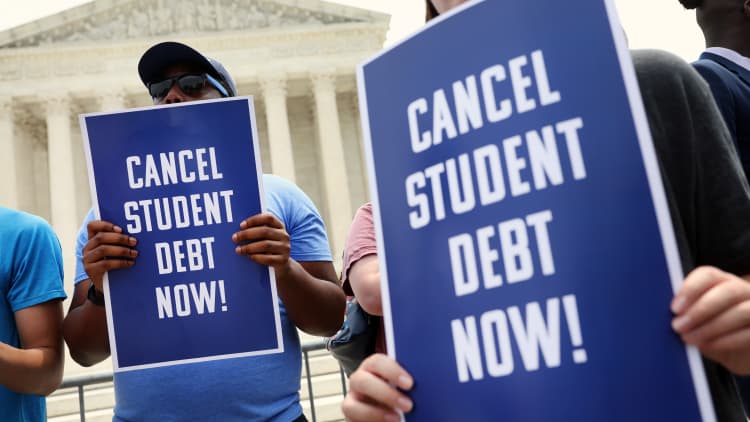Bymuratdeniz | E+ | Getty Images
Confusion between on-ramp period, payment pause
Betsy Mayotte, president of The Institute of Student Loan Advisors, a nonprofit, said she was not surprised that so many borrowers hadn’t paid their bill. In the past, default rates among student loan borrowers have skyrocketed when payments resumed after natural disaster-related forbearances.
“I also attribute some of it to some borrowers just not realizing payments have come due,” Mayotte said.
Former President Donald Trump first announced the stay on federal student loan bills and the accrual of interest in March 2020, when the Covid-19 pandemic hit the U.S. and crippled the economy. The pause was extended eight times.
I also attribute some of it to some borrowers just not realizing payments have come due.
Betsy Mayotte
president of The Institute of Student Loan Advisors
Nearly all people eligible for the relief took advantage of it, with less than 1% of qualifying borrowers continuing to make payments on their education debt, according to an analysis by higher education expert Mark Kantrowitz.
Scott Buchanan, executive director of the Student Loan Servicing Alliance, a trade group for federal student loan servicers, said he worried that some student loan holders were confusing the Biden administration’s 12-month “on-ramp” to repayment — during which they’re shielded from the worst consequences of falling behind — for another extension of the payment pause.
“There is a fundamental difference here,” Buchanan said. “Interest is accruing now.”
Throughout the payment pause, the interest rates on most federal student loans were set to zero, but interest began accruing again on Sept. 1. As a result, borrowers who don’t make payments now will see their balances grow.

Borrowers struggle to reenter student loan system
Many borrowers describe challenges trying to get current on their student loans, with long wait times trying to reach their servicers, errors with their bills, lost account information and confusion over new options rolled out over the past three years.
There had been several warnings that borrowers could face problems when their bills resumed.
In a court filing last year, Kvaal wrote that President Joe Biden’s broad student loan forgiveness plan was necessary to stave off “a historically large increase in the amount of federal student loan delinquency and defaults as a result of the COVID-19 pandemic.”
The Supreme Court rejected the president’s plan in June.
Even prior to the pandemic, when the U.S. economy was in one of its healthiest periods in history, nearly half of student loan borrowers were behind on their payments or enrolled in relief measures for those struggling, including deferments or forbearances, according to Kantrowitz.
Outstanding education debt in the U.S. exceeds $1.7 trillion, burdening Americans more than credit card or auto debt. The average loan balance at graduation has tripled since the ’90s, to $30,000 from $10,000. Around 7% of student loan borrowers are now more than $100,000 in debt.
The current payment numbers from the Education Department show that the student loan crisis is only worsening, said Astra Taylor, co-founder of the Debt Collective, a union for debtors.
“Faced with the impossible choice of feeding their kids, keeping a roof over their head or throwing an average of $400 a month into the Department of Education incinerator, borrowers are rightly choosing to keep themselves and their families financially afloat,” Taylor said.

